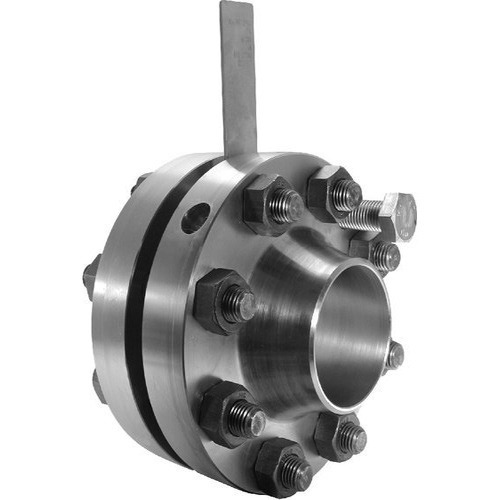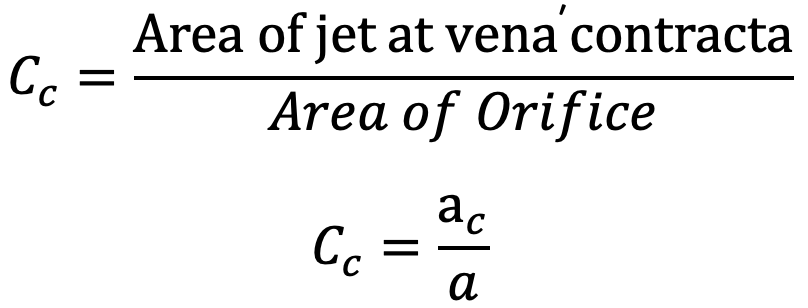An Orifice Meter is a device used for measuring the rate of now of a fluid through a pipe. It also works on the same Bernoulli’s principle as that of the Venturimeter. In this article, we will discuss the different Hydraulic Coefficients of Orifice meter in a detailed manner.

Orifice Meter
It consists of a flat circular plate with a circular sharp-edged hole called an orifice, which is concentric with the pipe. The orifice diameter is generally kept 0.5 times the diameter of the pipe, though it may vary from 0.4 to 0.8 times the pipe diameter.

Classification of Orifice Meter
The orifices are classified on the basis of their size, shape, nature of discharge and shape of the upstream edge.
The following are the important classifications of orifices
- Small orifices or Large orifices: The orifices are classified as small orifices or large orifices depending upon the size of the orifice and the head of liquid from the centre of the orifice.
- If the head Of liquid from the centre of the orifice is more than five times the depth of the orifice, the orifice is called a small orifice.
- If the head of liquids is less than five times the depth of the orifice, it is known as a large orifice.
- The orifices are classified based on their cross-sectional areas as follows
(i) Circular orifice,
(ii) Triangular orifice
(iii) Rectangular orifice
(iv) Square orifice - The orifices are classified based on the shape of the upstream edge of the orifices as follows
(i) Sharp-edged orifice
(ii) Bell-mouthed orifice - The orifices are classified based on the nature of the discharge as follows
- (i) Free discharging orifices
- (ii) Drowned or sub-merged orifices
- The submerged orifices are further classified as
(a) Fully submerged orifices
(b) Partially submerged orifices
- The submerged orifices are further classified as
Hydraulic Coefficients
We have 3 important hydraulic coefficients when we study the flow of fluids through the orifices, pitot tubes or nozzles. Those are
- Coefficient of velocity, Cv
- Coefficient of contraction, Cc
- Coefficient of discharge, Cd
1. Coefficient of velocity (Cv)
The coefficient of velocity is defined as the ratio between the actual velocity of a jet of liquid at vena-contracta and the theoretical velocity of the jet.
It is denoted by Cv and mathematically, Cv is given as

Where
v = actual velocity
√(2gH)= Theoretical velocity
The value of Cv varies from 0.95 to 0.99 for different orifices, depending on the shape, and size of the orifice and on the head under which now takes place.
Generally, the value of Cv 0.98 is taken for sharp-edged orifices.
2. Coefficient of contraction (Cc)
Coefficient of contraction is defined as the ratio of the area of the jet at vena-contracta to the area of the orifice..
It is denoted with Cc.

Where
a = area of the orifice
ac = Are of the jet ar the vena-contracta
The Value of Cc varies from 0.61 to 0.69 depending on the shape and size of the orifice and the head Of the liquid under which flow takes place.
In general, the value Of Cc may be taken as 0.64.
3. Coefficient of discharge (Cd)
Coefficient of discharge is defined as the ratio of the actual discharge from an orifice to the theoretical discharge from the orifice.
It is denoted by Cd.
If Q is the actual discharge and the Qth is the theoretical discharge, then the Coefficient of discharge is mathematically given by

The Value of Cd varies from 0.61 to 0.65. For general purpose the value of Cd is taken as 0.62.
Example Problem to find the Hydraulic Coefficients of a fluid flow
Problem Statement: The head of water over an orifice of diameter 40 mm is 10 m. Find the actual discharge and actual velocity of the jet at vena-contracta. Take Cd 0.6 and Cv 0.98.
Answer:
Given that
Head H = 10cm
diameter of the orifice d = 40mm = 0.04m
Area = a = ℼ/4 (0.4)2 = 0.001256 m2
Cd = 0.6
Cv = 0.98
(i) Actual Discharge
Actual discharge / Theoretical discharge = 0.6
We know the Theoretical discharge = Vth × Area of the Orifice
Vth = theoretical velocity
Vth = √(2gH) = √(2×9.81×10) = 14 m/s
Theoretical discharge = 14 × 0.001256 = 0.01758 m2/s
Actual Discharge = 0.6 × Theoretical discharge
Actual Discharge = 0.6 × 0.01758
Actual Discharge = 0.01054 m3/s
(ii) Actual Velocity
Actual Velocity / Theoretical Velocity = Cv = 0.98
Actual Velocity = 0.98 × Theoretical Velocity
Actual Velocity = 0.98 × 14
Actual Velocity = 13.72 m/s
This is all about finding the hydraulic Coefficients of fluid flowing through the Orifice.

Leave a Reply